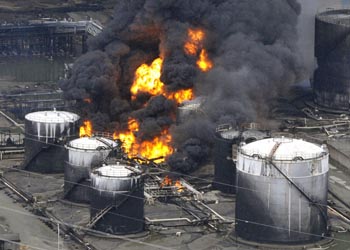KUCHING: The nation’s electrical and electronics (E&E) sector may suffer a temporary ‘dent’ as a result of last Friday’s 8.9-magnitude earthquake in Japan.

MAJOR CONTRIBUTOR: Photo shows a factory facility burning following an earthquake and tsunami in Sendai, Northeastern Japan. Chia says E&E exports to Japan and the rest of Asia are a major contributor to Malaysia’s industrial production and a supply disruption is unwelcome. – Reuters photo
“Malaysia and other Asian countries complement the supply chain by producing raw materials or lower value-added components. E&E exports to Japan and the rest of Asia are a major contributor to Malaysia’s industrial production and a supply disruption is unwelcome,” said ECM Libra economist, Michelle Chia in her economic analysis yesterday.
The economist stated that directly, Japan accounted for RM66.3 billion or 10.4 per cent of Malaysia’s exports and RM66.5 billion or 12.6 per cent of Malaysia’s imports.
“Malaysia runs a trade deficit with Japan in machinery and transport items (M&T) totalling RM18.9 billion. Of this, M&T exports to Japan amount to RM19.4 billion, RM18 billion of which are semiconductors and other E&E products.”
“Indirectly, however, demand for Malaysia’s E&E exports may be affected due to Asia’s fragmented supply chain, of which Japan plays a key role,” she highlighted.
She said that globally, one fifth of semiconductors, and two fifth of flash memory drives were from Japan.
“The area worst hit by the tsunami and earthquake is home to auto, semiconductor and other E&E industries. While factories have escaped significant damage, concerns remain over the immediate power supply and radiation leakage from the nearby nuclear power plants. A disruption in one area of production could have a major impact on the production lines in other countries,” she added.
According to Chia, Japan is a major component of the vertically integrated intra-Asian supply chain, as exemplified by large trade flows with China and the Asean countries.
Its manufacturing exports were key sources of high value-added intermediate inputs for the processing trade, especially in the E&E and machinery segments.
Meanwhile, the economist noted that Malaysia stood to benefit from Japan’s need to replace lost nuclear energy capacity, considering mineral fuels were part of the country’s major export item.
She pointed out that during a shutdown of 17 nuclear reactors in 2002 totalling 17,308 megawatt (MW), imports of petroleum and liquefied natural gas (LNG) rose by 5.3 per cent and 9.7 per cent year-on-year (y-o-y).
“Assuming complete substitution of the 11,964MW in all 14 reactors lost today with LNG thermal plants, Japanese petroleum and LNG import demand for this year could rise a further 4.3 per cent and 5.2 per cent respectively from the 2010 levels,” Chia added.
Besides that, the economist opined that Malaysia was also in a good position to take advantage of the looming demand for building materials like timber and steel unleashed by reconstruction efforts.
“On a marginal basis, the appreciation of yen, which has been sustained by its current account surplus, status as international creditor and substantial domestic holding of Japanese assets may help the competitive advantage of Malaysian exports,” she remarked.
On another note, Chia stated that the destruction of wealth in Japan would probably weigh on purse strings, cutting the amount of disposable income and the propensity to spend on vacations.
However, Japan accounted for only 1.7 per cent of total tourist arrivals to Malaysia, thus the hit to the tourism sector was likely to be minimal.
Chia stated that the catastrophe in Japan triggered a repatriation of overseas funds. The bulk of Japanese portfolio outflows were concentrated in the Organisation of Economic Co-operation and Development (OECD) countries.
“The impact of ‘hot flows’ in the Asean region are expected to be limited as net bond and equity portfolio flows to the Asean region are not sizeable.
“Over the longer term though, the need to redirect funds internally to fund reconstruction activities may limit the flow of foreign direct investments (FDI) to other countries. Malaysia has received significant inflows of FDIs from Japan, particularly in the manufacturing sector,” Chia concluded. |
